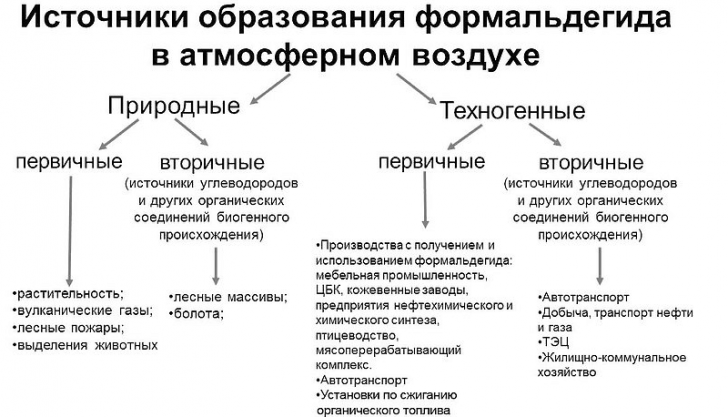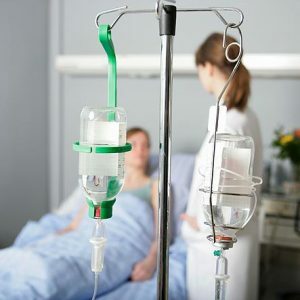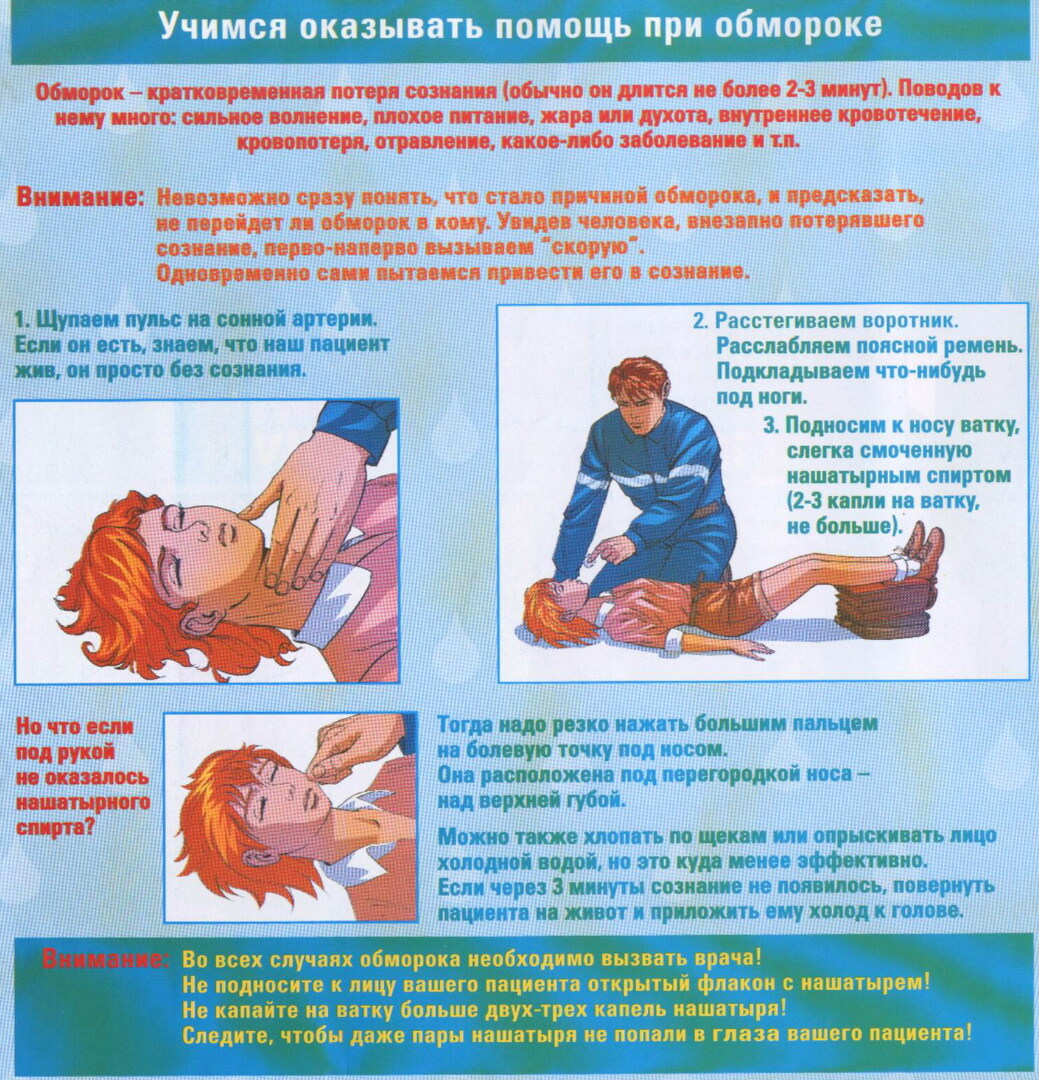Thromboembolism of the pulmonary artery: symptoms and treatment
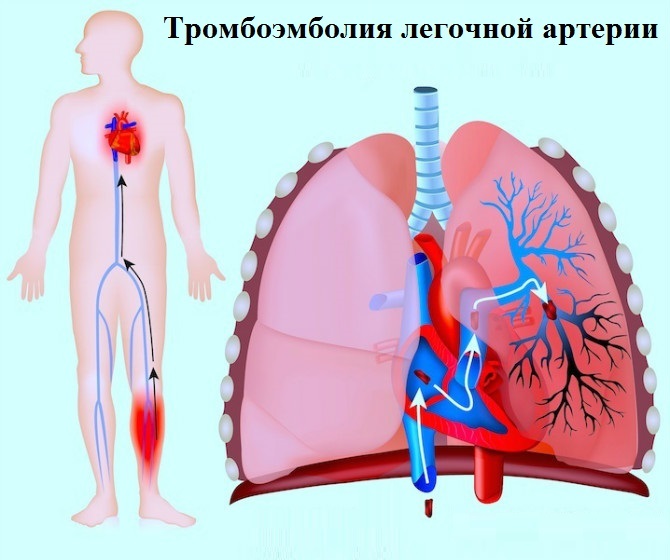 Thromboembolism of the pulmonary artery( PE) is an exceptionally severe complication of diseases in which increased thrombus formation in the veins is observed.A blood clot penetrates the pulmonary artery, completely clogging either its entire, or one( or several) of its branches, causing a characteristic clinical picture.
Thromboembolism of the pulmonary artery( PE) is an exceptionally severe complication of diseases in which increased thrombus formation in the veins is observed.A blood clot penetrates the pulmonary artery, completely clogging either its entire, or one( or several) of its branches, causing a characteristic clinical picture.
Small Circuit Vessels
The pulmonary artery is a large blood vessel that extends from the right atrium to theEasy.Venous blood flows through it, which is enriched in oxygen in the alveolar system and supplies the entire body with this gas.

After exiting the heart, the pulmonary artery divides first into the right and left branches, which are further divided into lobar arteries, then into separate branches that penetrate the lung segments and continue until the large arterial trunk turns into a network of microscopic capillaries.
The sites of branching of arteries are those points where clots most often get stuck, blocking the flow of blood.There may be a blockage outside the branching points, but this happens somewhat less frequently.
Causes of development of pulmonary embolism
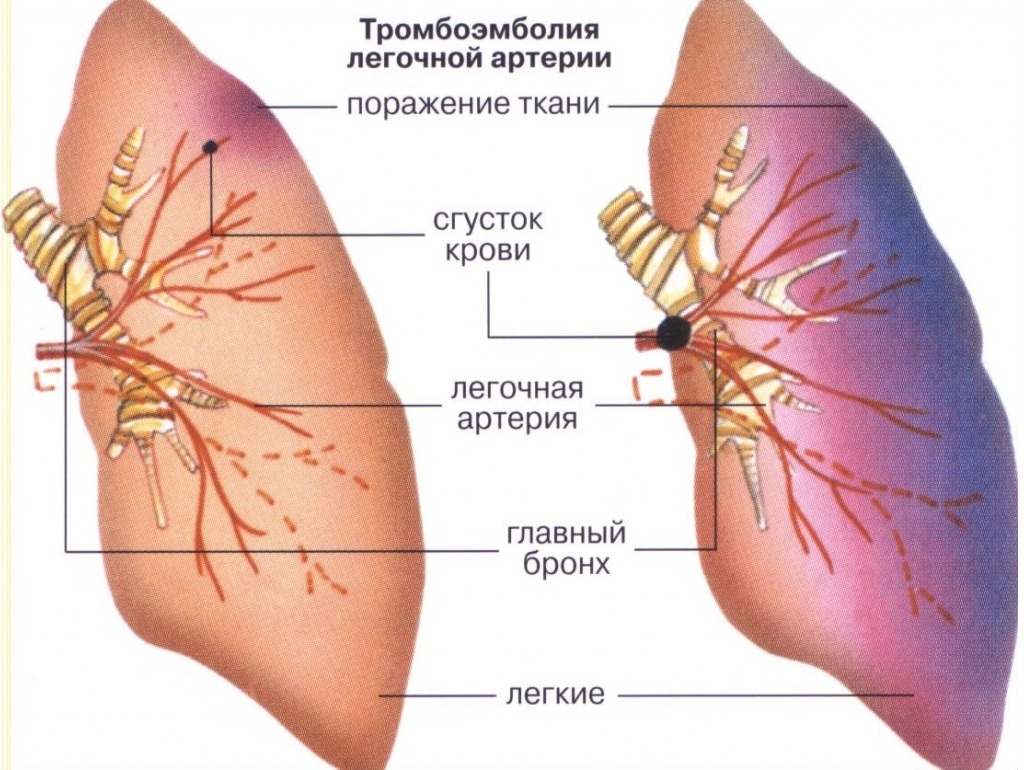
In the vast majority of cases, PE is caused by blockage of the lumen of the artery or its branches by thromboembols formed in the deep veins of the lower limbs.Quite often the cause is clots of blood from the system of the inferior vena cava, renal, iliac veins and the right atrium with atrial fibrillation.
There are a number of factors that contribute to the formation of venous thrombi:
- blood stasis, which occurs mainly in the absence of physical exertion in case of paralysis, prolonged bed rest, varicose veins, squeezing of the vessels with tumors, infiltrates, cysts;
- is an increase in blood clotting, which is most often hereditary, although it can be triggered by the intake of certain medications( eg, oral contraceptive pills);
- damage to the vascular wall due to injuries, surgical interventions, thrombophlebitis, damage by its viruses, free radicals during hypoxia, poisons.
These factors are called by the Virchow triad by the name of the author who first described them.
The main cause of PE is floating thrombi, that is, blood clots attached to the wall of one of the veins and freely "dangling" in the lumen of the vessel.Increase of intravascular pressure due to sudden physical exertion or defecation can lead to their separation and movement into the pulmonary artery system.
Symptoms of pulmonary embolism
Symptomatic of pulmonary embolism is very variable and mildly specific.There is no symptom, in the presence of which it was possible to say exactly what a patient has.
The classic complex of lesions of the pulmonary trunk and / or major arteries includes:
- retrosternal pain;
- arterial hypotension;
- upper body cyanosis;
- increased respiration and
- neck vein swelling
A full range of symptoms occurs in only one in seven patients, but one or two signs from this list are found in all patients.And if the smaller branches of the pulmonary artery suffer, the diagnosis of PE is often exhibited only at the stage of the formation of a pulmonary infarct, that is, after 3-5 days.
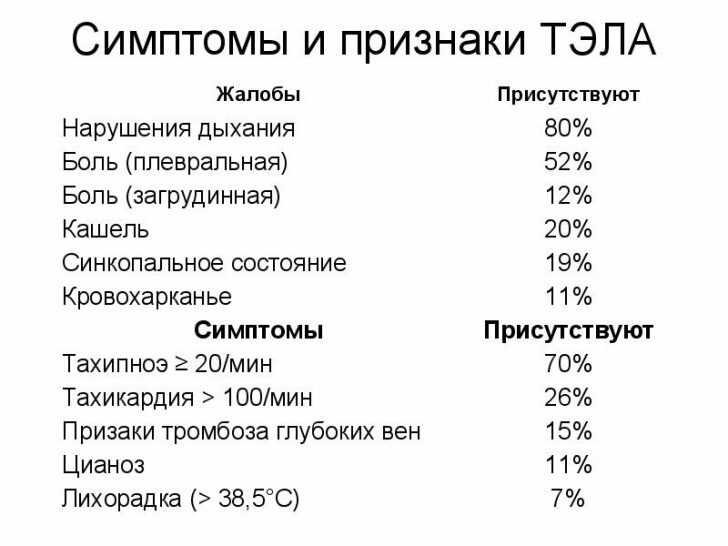
Nevertheless, a thorough examination of the anamnesis suggests a possible development of PE in this patient.
During the history of anamnesis, the following are identified:
- presence of diseases that increase the risk of thrombosis;
- compliance with long-term bed rest;
- long journeys in motor transport( sitting position);
- stroke in the past;
- recent injuries and surgeries;
- oral contraceptive intake;
- pregnancy, childbirth, abortion, including spontaneous( miscarriage);
- episodes of any thrombosis, including PE, transferred in the past;
- episodes of thromboembolism among blood relatives,
Back pain is the most frequent symptom of PE that occurs in approximately 60% of cases.It is he who most often is the "culprit" of diagnostic errors, since it is very similar to pain in ischemic heart disease.
Almost half of patients develop severe weakness, most often associated with a sudden drop in blood pressure.Pale skin is noted in 60% of patients.Simultaneously, there is an increase in the pulse.
When examined, the patient has severe shortness of breath, but he does not accept the forced position of the orthopnea( sitting with his hands resting on the edge of the bed).The person experiences difficulties when inhaling: this condition is often described as "the patient catches the air with his mouth."
When lesions of small branches of the pulmonary artery, the symptomatology at the outset can be erased, nonspecific. Only on day 3-5 there are signs of a lung infarction:
- pleural pain;
- cough;
- hemoptysis;
- appearance of pleural effusion.
Involvement in the pleura process is revealed when the lungs are examined with a phonendoscope.At the same time, weakening of breathing above the zone of damage is noted.
In parallel with the diagnosis of PE, the doctor must determine the source of thrombosis, and this is a rather difficult task.The reason is that thrombus formation in the veins of the lower extremities often proceeds asymptomatically even with massive embolism.
Laboratory and instrumental diagnostics
There are no laboratory diagnostic methods that reliably confirm the diagnosis of PE.Blood coagulation tests do not provide the necessary information, although they are needed for treatment.Determination of the titre of D-dimers is a very accurate, but completely non-specific analysis.He helps in diagnosing only when you can confidently exclude other reasons for its increase.At the same time, this analysis because of its high sensitivity can be used to monitor the patient's condition and the response of his body to medical interventions.
The methods of instrumental diagnosis of PE include:
- ECG, which can give some data on changes in the myocardium;
- is an overview radiograph of the chest showing some indirect signs of embolism;The same method makes it possible to detect a focus of a lung infarction;
- echocardiogram helps to identify violations of hemodynamics in the cavities of the heart, to detect thrombi in its chambers, to assess the structural state of the heart muscle;
- perfusion lung scanning using radioisotopes allows detection of places with zero or reduced blood supply;This is a sufficiently specific and safe method;
- right heart probing and angiopulmonography are the most informative method currently available;With its help are precisely defined as the fact of embolism, and the extent of the lesion;
- computed tomography gradually replaces the previous method, as it helps to get all the necessary data without the risk of serious complications.
Treatment of Pellets
The main goal of treatment for pulmonary embolism is to preserve the patient's life and prevent chronic pulmonary hypertension.First of all, it is necessary to restore the patency of blocked arteries, as this leads to the normalization of hemodynamics.
The main method of treatment is medicamentous, to surgical resort only in cases of ineffectiveness of conservative therapy, with serious violations of hemodynamics or development of acute heart failure.
Direct anticoagulants are used from medicines:
- Heparin;
- dalteparin;
- supraparin;
- enoxaparin and thrombolytic agents:
- streptokinase( high risk of complications, however relatively cheap);
- alteplase - highly effective, rarely causes anaphylactic shock;
- Prourokinase is the safest drug.
Surgical treatment is an operation of embobectomy, that is, the removal of a thrombus from the artery.It is carried out by catheterization of the pulmonary artery under conditions of artificial circulation.
Pellet Prophylaxis
It is possible to prevent the development of PE by eliminating or minimizing the risk of thrombus formation. To do this, use all possible methods:
- maximum reduction in the length of bed rest;
- early activation of patients;
- elastic compression of the lower extremities with special bandages, stockings etc.
In addition, people at risk:
- is over 40 years old;
- with malignant tumors;
- lying sick;
- previous episodes of thrombosis.
Those who have a massive operation, are routinely prescribed anticoagulants to prevent the formation of blood clots.
With existing venous thrombosis, surgical prophylaxis can be performed using the following methods:
- implanting the filter into the lower vena cava;
- plication( creation of the inferior vena cava special folds impermeable thrombi, about transmissive blood;
- endovascular catheter thrombectomy( removal of thrombus from the vein through a catheter inserted in it);
- ligation great saphenous or femoral vein - the main sources of thrombus formation.
pulmonary embolism - it is a serious disease, especially if major blood vessels become clogged early start physical activity after injuries and operations contribute to the reduction.the risk of this disease, and careful attention to your health may help early diagnosis and cure it.
Bozbey Gennadiy Andreevich, emergency doctor
medical care

